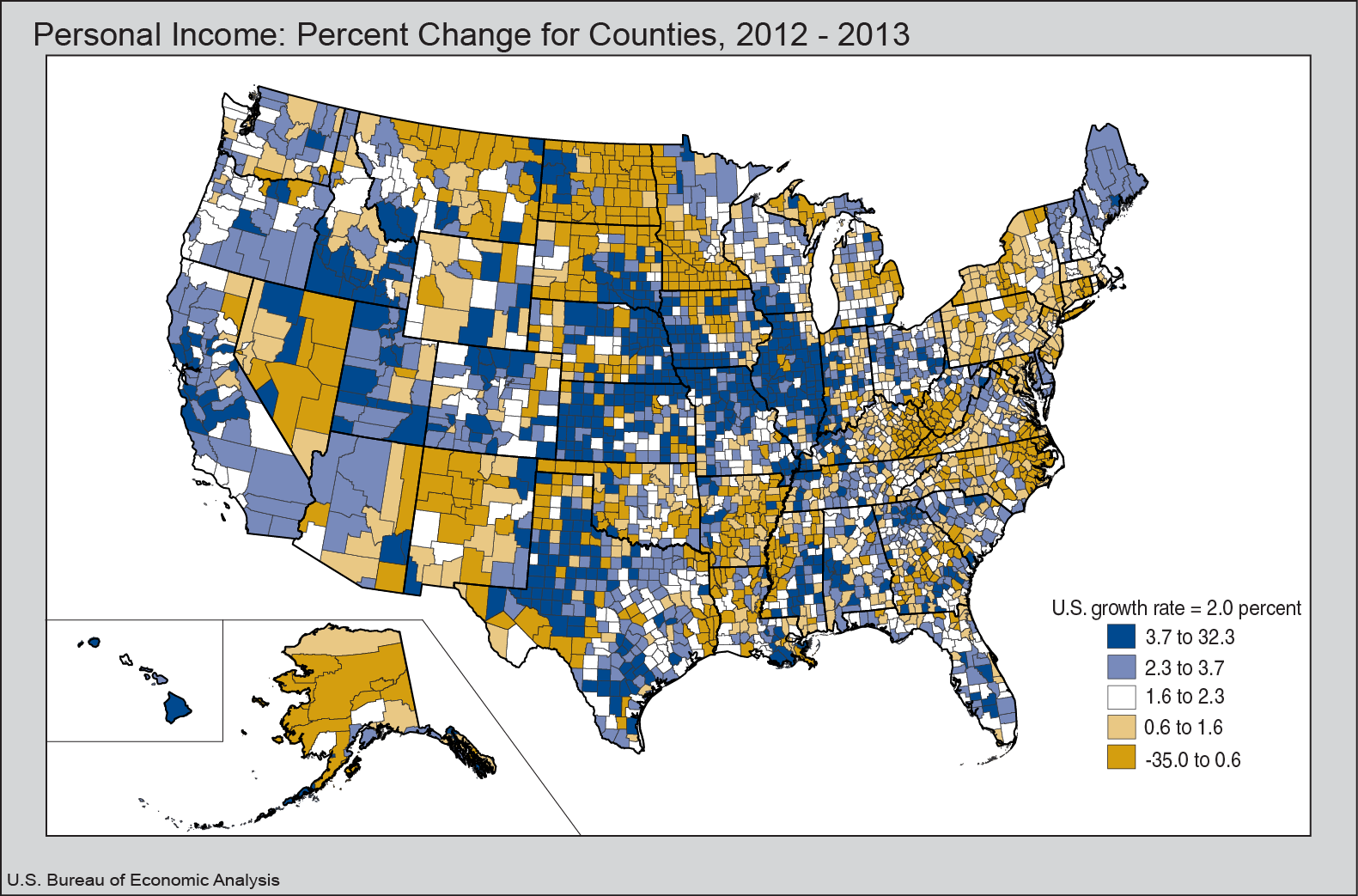News Release
Local Area Personal Income, 2011-2013
Personal income grew in 2013 in 2,695 counties, fell in 390, and was unchanged in 28, according to estimates released today by the U.S. Bureau of Economic Analysis. On average, personal income rose 2.0 percent in 2013 in the metropolitan portion of the United States and rose 2.1 percent in the nonmetropolitan portion. The metropolitan and nonmetropolitan portions grew 5.3 percent and 4.4 percent, respectively, in 2012. The percent change from 2012 to 2013 in personal income ranged from -35.0 percent in LaMoure County, North Dakota to 32.3 percent in Greeley County, Kansas. Inflation, as measured by the national price index for personal consumption expenditures, slowed to 1.2 percent in 2013 from 1.8 percent in 2012.
Personal income is the income received by, or on behalf of, all persons from all sources: from participation as laborers in production, from owning a home or business, from the ownership of financial assets, and from government and business in the form of transfer receipts. It includes income from domestic sources as well as from the rest of the world.
Personal income is the income that is available to persons for consumption expenditures, taxes, interest payments, transfer payments to governments and the rest of the world, or for saving. Personal income for 2013 ranged from $3.8 million in Loving County, Texas to $466.1 billion in Los Angeles County, California. Per capita personal income—personal income divided by population—is a useful metric for making comparisons of the level of personal income across counties. Per capita personal income for 2013 ranged from $17,536 in Telfair County, Georgia to $121,632 in New York County, New York.
The county personal income estimates released today continue the successively more detailed series of data releases from the Bureau of Economic Analysis (BEA) depicting the geographic distribution of the nation's personal income for 2013. National estimates of personal income for 2013 were released in January 2014, followed by preliminary state personal income estimates in March. The personal income estimates released today provide the first glimpse of personal income for 2013 in counties and metropolitan statistical areas. The geographic picture will be completed with the release of real personal income for states and metropolitan areas in July 2015.
With this statistical release, BEA has implemented an improved system for identifying and applying secondary data suppressions to protect confidential wage source data used in BEA's regional statistics. The new system generates 13 percent fewer suppressions. The reduction in suppressions means that earnings, compensation, and employment estimates will be published for more industries, especially for metropolitan statistical areas.
Definitions
Personal income is the income received by all persons from all sources. Personal income is the sum of net earnings by place of residence, property income, and personal current transfer receipts. Net earnings is earnings by place of work (the sum of wages and salaries, supplements to wages and salaries, and proprietors' income) less contributions for government social insurance, plus an adjustment to convert earnings by place of work to a place-of-residence basis. Property income is rental income of persons, personal dividend income, and personal interest income. Personal income is measured before the deduction of personal income taxes and other personal taxes and is reported in current dollars (no adjustment is made for price changes).
Per capita personal income is calculated as the personal income of the residents of a given area divided by the resident population of the area. In computing per capita personal income, BEA uses the Census Bureau's annual midyear population estimates.
Availability of data on the BEA Web site
The complete set of local area personal income statistics for 1969–2013 for counties, metropolitan statistical areas, micropolitan statistical areas, combined statistical areas, metropolitan divisions, and state metro/nonmetro portions is now available interactively on BEA's Web site. Go to www.bea.gov/iTable/index_regional.cfm to access these statistics which include earnings and compensation by industry, gross earnings inflows and outflows associated with commuters, and other components of personal income. In addition, the Web site has mapping and charting applications and a detailed methodology.
BEA Regional Facts (BEARFACTS), a narrative summary of personal income, per capita personal income, and components of income for counties, metropolitan statistical areas and states, is available on BEA's Web site. Go to www.bea.gov/regional/bearfacts/ to access these summaries.
****
Local area personal income statistics can be used, among other ways, in economic models to project tax revenues and the demand for public utilities and services, to determine areas for locating, expanding, and closing businesses, to analyze the economic impact of disasters, and to determine whether an area has sufficient income to undertake and support specific projects and activities to encourage economic development.
****
An article about the local area personal income statistics will be published in the December issue of the Survey of Current Business, the monthly journal of the Bureau of Economic Analysis.
****
BEA's national, international, regional, and industry statistics; the Survey of Current Business; and BEA news releases are available without charge on BEA's Web site at www.bea.gov. By visiting the site, you can also subscribe to receive free e-mail alerts of BEA news releases and announcements.
****
The next data release with local area personal income statistics, scheduled for July 1, 2015 at 8:30 A.M., will be Real Personal Income for State and Metropolitan Areas, 2013.
